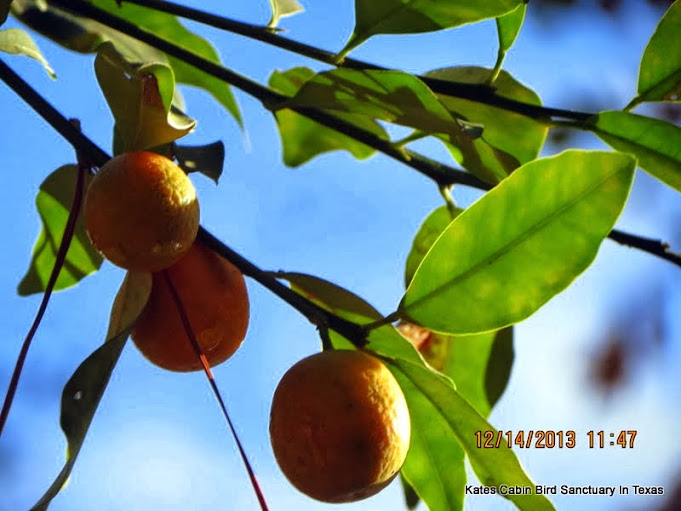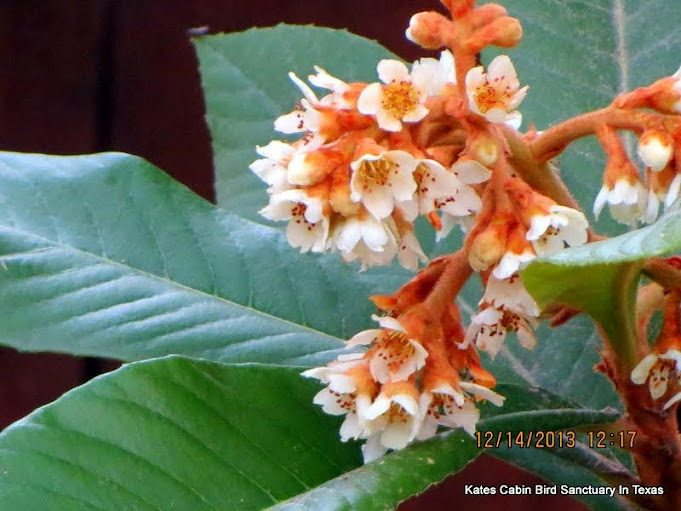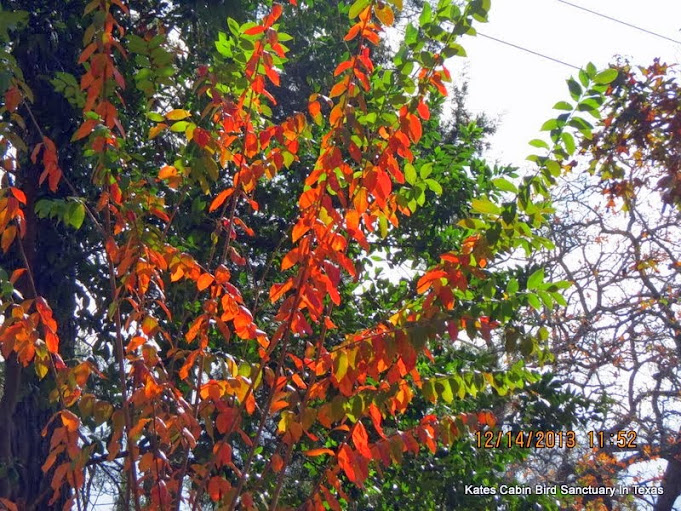
Hi Everybody!!
We have a tasty little treat for you tonight: The Kumquats are ready! I will make a special chutney for Christmas. The light freeze did not hurt the Loquat blooms so they are still in bloom and bees are pollinating to make the fruit. What are Kumquats and Loquats? Below I have shared info from Wikipedia so you will be "in the know"! These fruits are not as popular in the States as in other parts of the world. I have trees of both growing in the yard and they are a great addition to any garden. More cold arrived today. For a short time, the morning cloud cover was frozen and split to reveal the blue sky and bright sunshine! I caught a little bit of Sunshine for your day before th cloud cover closed up. Enjoy!







link to photostudy in G+ album:
https://plus.google.com/u/0/photos/117645114459863049265/albums/5957415835266631377

Kumquat







https://en.wikipedia.org/wiki/Kumquat
Kumquat
From Wikipedia, the free encyclopedia
Kumquats or cumquats are a group of small fruit-bearing trees in the flowering plantfamily Rutaceae, either forming the genus Fortunella, or placed within Citrus sensu lato. The edible fruit closely resembles that of the orange (Citrus sinensis), but it is much smaller and ovular, being approximately the size and shape of a large olive. The English name "kumquat" derives from the Cantonese pronunciation gam1 gwat1 (given in Jyutping romanization).
They are slow-growing evergreen shrubs or short trees, from 2.5 to 4.5 meters (8 to 15 ft) tall, with dense branches, sometimes bearing small thorns. The leaves are dark glossy green, and the flowers are white, similar to other citrus flowers, borne singly or clustered in the leaf-axils. Depending on size, the kumquat tree can produce hundreds or even thousands of fruits each year.[1] The tree can be hydrophytic, grown in water, with the fruit often found floating on water near shore during the ripe season.[citation needed]
The plant is native to south Asia and the Asia-Pacific region. The earliest historical reference to kumquats appears in literature of China in the 12th century. They have long been cultivated in Japan, Taiwan, the Philippines, and southeast Asia. They were introduced to Europe in 1846 by Robert Fortune, collector for the London Horticultural Society, and shortly thereafter into North America.
| Kumquat | |
|---|---|
 | |
| Malayan kumquat foliage and fruit | |
| Scientific classification | |
| Kingdom: | Plantae |
| (unranked): | Angiosperms |
| (unranked): | Eudicots |
| (unranked): | Rosids |
| Order: | Sapindales |
| Family: | Rutaceae |
| Subfamily: | Aurantioideae |
| Tribe: | Citreae |
| Genus: | Citrus |
| Species: | C. japonica |
Round kumquat[edit]
When the kumquats are divided into multiple species, the name Fortunella japonica(or Citrus japonica) is retained by this group. The round kumquat also called Marumi kumquat or Morgani kumquat, is an evergreen tree, producing edible golden-yellow fruit. The fruit is small and usually round but can be oval shaped. The peel has a sweet flavor but the fruit has a sour center. The fruit can be eaten cooked but is mainly used to make marmalades and jellies. It is grown as an ornamental plant and can be used in bonsai. The plant symbolizes good luck in China and other Asian countries, where it is kept as a houseplant and given as a gift during the Lunar New Year. Round kumquats are more commonly cultivated than other species due to their cold tolerance.
Cultivation and uses[edit]
Kumquats are cultivated in China, South Korea, North Korea, Taiwan, Southeast Asia,Nepal, Japan, the Middle East, Iran, Europe (notably Corfu, Greece), southernPakistan, and the southern United States (notably Florida, Louisiana, Alabama) and California.
They are much hardier than other citrus plants such as oranges. The 'Nagami' kumquat requires a hot summer, ranging from 25 °C to 38 °C (77 °F to 100 °F), but can withstand frost down to about −10 °C (14 °F) without injury. They grow in the tea hills of Hunan, China, where the climate is too cold for other citrus fruits, even theMikan (also known as the Satsuma) orange. The trees differ also from other citrus species in that they enter into a period of winter dormancy so profound that they will remain in it through several weeks of subsequent warm weather without putting out new shoots or blossoms. Despite their ability to survive low temperatures, kumquat trees grow better and produce larger and sweeter fruits in warmer regions.
Kumquats do not grow well from seeds and so are vegetatively propagated, using rootstock of another citrus fruit.[4]
Uses[edit]
Kumquats are often eaten raw. As the rind is sweet and the juicy center is sour, the raw fruit is usually consumed either whole—to savor the contrast—or only the rind is eaten. The fruit is considered ripe when it reaches a yellowish-orange stage and has just shed the last tint of green.
Culinary uses include candying and kumquat preserves, marmalade, and jelly. Kumquats can also be sliced and added to salads. In recent years kumquats have gained popularity as a garnish for cocktail beverages, including the martini as a replacement for the more familiar olive. A kumquat liqueur mixes the fruit with vodka or other clear spirit. Kumquats are also being used by chefs to create a niche for their desserts[clarification needed] and are common in European countries.[citation needed]
The Cantonese often preserve kumquats in salt or sugar.[citation needed] A batch of the fruit is buried in dry salt inside a glass jar. Over time, all the juice from the fruit is diffused into the salt. The fruit in the jar becomes shrunken, wrinkled, and dark brown in color, and the salt combines with the juice to become a dark brown brine. A few salted kumquats with a few teaspoons of the brine/juice may be mixed with hot water to make a remedy for sore throats.[citation needed]A jar of such preserved kumquats can last several years and still keep its flavor.[citation needed]
In the Philippines and Taiwan, kumquats are a popular addition to green tea and black tea, either hot or iced.[citation needed]
In Vietnam, kumquat bonsai trees (round kumquat plant) are used as a decoration for the Tết (Lunar New Year) holiday. Kumquat fruits are also boiled or dried to make a candied snack called mứt quất.[citation needed]
Variants of the kumquat are grown specially in India.
The kumquat is celebrated annually in Dade City, Florida, U.S.A. with the annual Kumquat Festival.
Loquat




https://en.wikipedia.org/wiki/Loquat
Loquat
From Wikipedia, the free encyclopedia
| Loquat Eriobotrya japonica | |
|---|---|
 | |
| Loquat leaves and fruits | |
| Scientific classification | |
| Kingdom: | Plantae |
| (unranked): | Angiosperms |
| (unranked): | Eudicots |
| (unranked): | Rosids |
| Order: | Rosales |
| Family: | Rosaceae |
| Genus: | Eriobotrya |
| Species: | E. japonica |
Fruit[edit]
Loquats are unusual among fruit trees in that the flowers appear in the autumn or early winter, and the fruits are ripe in late winter or early spring. The flowers are 2 cm (1 in) in diameter, white, with five petals, and produced in stiff panicles of three to ten flowers. The flowers have a sweet, heady aroma that can be smelled from a distance.
Loquat fruits, growing in clusters, are oval, rounded or pear-shaped, 3–5 cm long, with a smooth or downy, yellow or orange, sometimes red-blushed skin. The succulent, tangy flesh is white, yellow or orange and sweet to subacid or acid, depending on the cultivar.
Each fruit contains from one to ten ovules, with three to five being most common.[6] A variable number of the ovules mature into large brown seeds. The skin, though thin, can be peeled off manually if the fruit is ripe. In Egypt varieties with sweeter fruits and fewer seeds are often grafted on inferior quality specimens.[citation needed]
The fruits are the sweetest when soft and orange. The flavor is a mix of peach, citrus and mild mango.
Culinary use
The loquat has a high sugar, acid, and pectin content. It is eaten as a fresh fruit and mixes well with other fruits in fresh fruit salads or fruit cups. The fruits are also commonly used to make jam, jelly, and chutney, and are often served poached in light syrup. Firm, slightly immature fruits are best for making pies or tarts.
The fruit is sometimes canned. The waste ratio, however, is 30 percent or more, due to the seed size.
The fruit is also processed into confectioneries.
Loquats are abundant in Pakistan, from Islamabad north, during the month of April, where the sour unripe fruit are used to make chutneys and sauces.


...this is brendasue signing off from Rainbow Creek. See You next time! Brrrrrrrrrrrr! It is cold here!







O+O


No comments:
Post a Comment
Hi Everybody! Please say hello and follow so I know you are here! Due to the inconsideration of people trying to put commercials on my blog comment area, I have restricted use of anonymous posts. Sorry that some hurt all.
My public email is katescabin@gmail.com No spammers or trolls